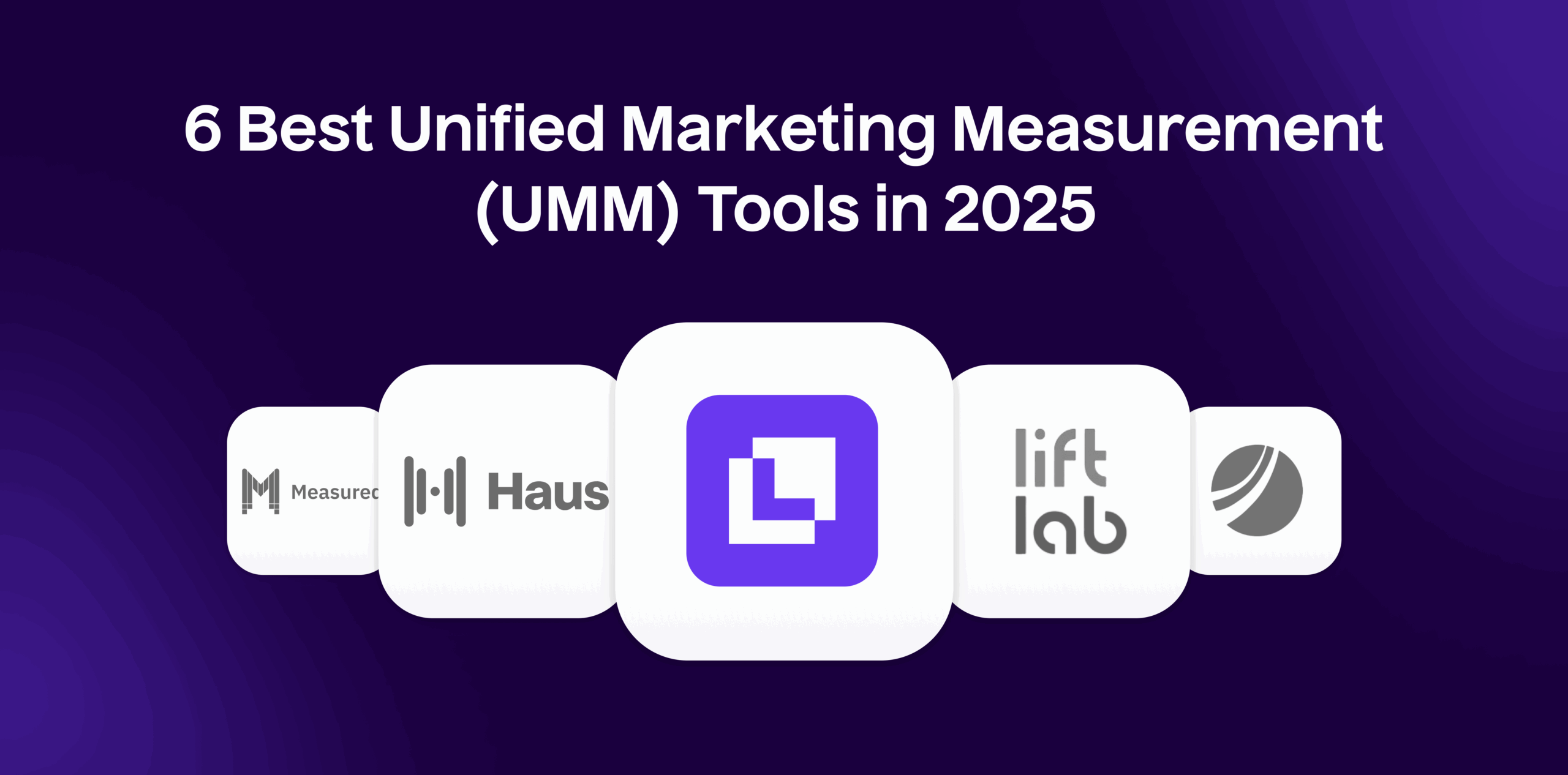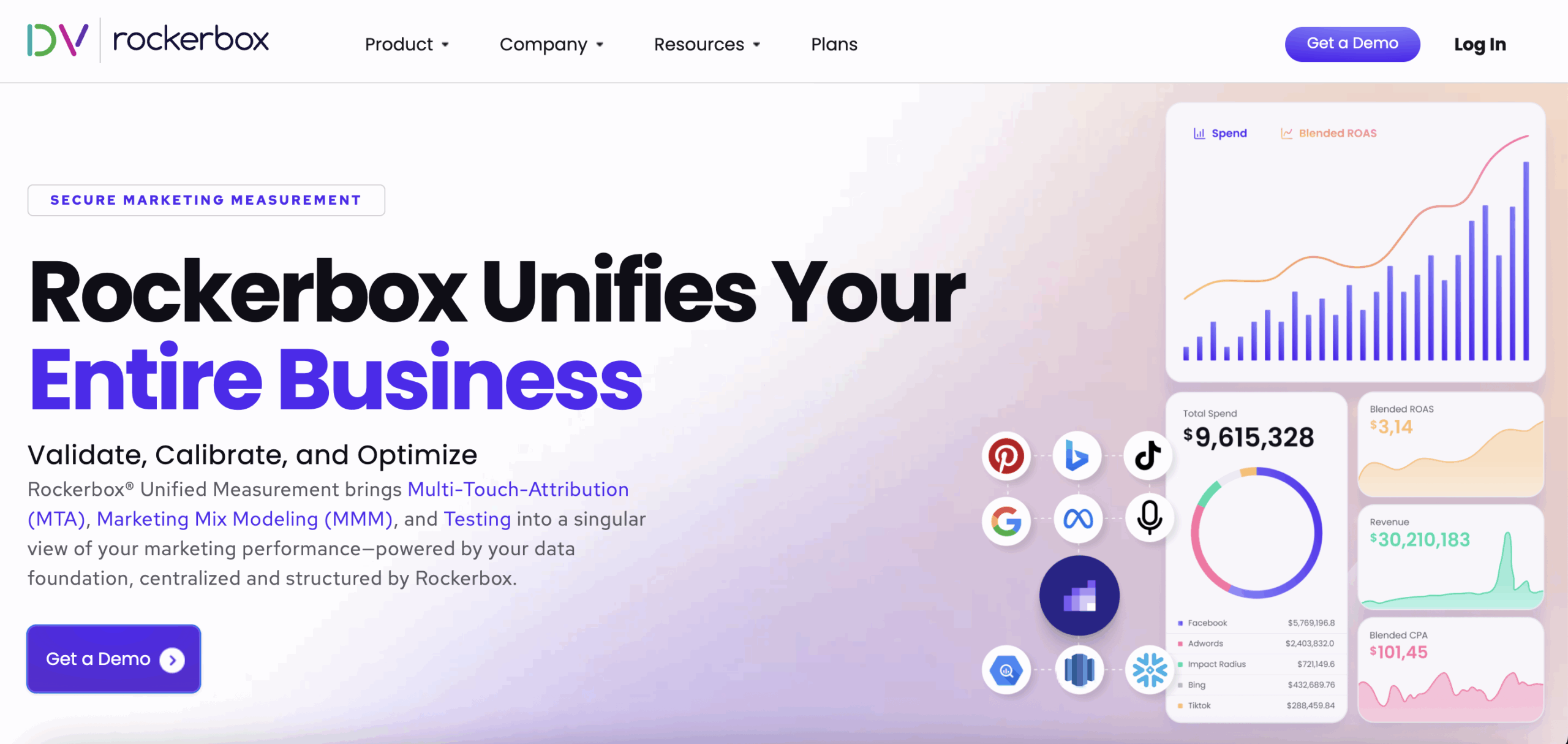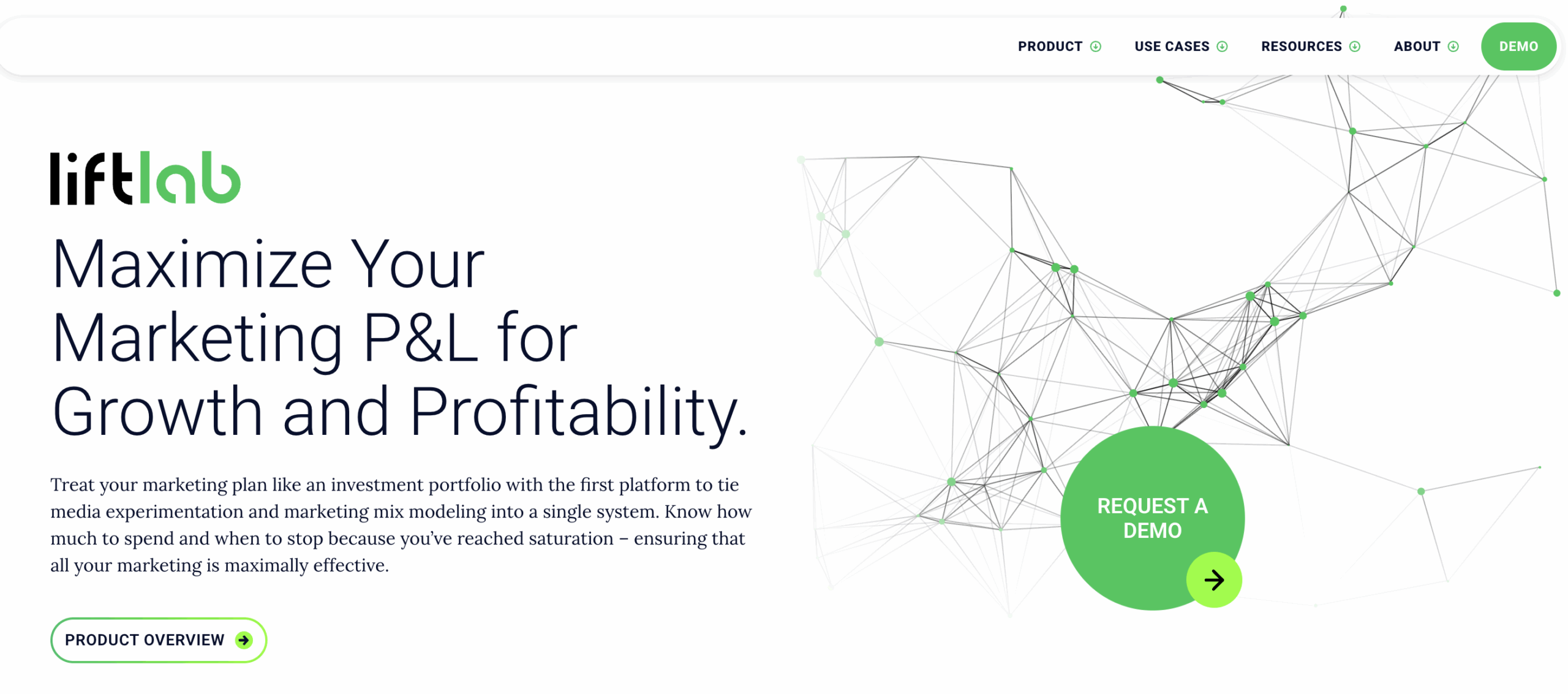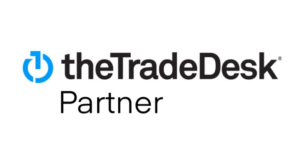As the digital marketing landscape continues to evolve, businesses face increasing complexity when it comes to accurately measuring marketing effectiveness. Traditional analytics tools often fall short in capturing the full picture, leaving marketers with incomplete or biased insights. This is where Unified Marketing Measurement (UMM) tools come into play. By combining advanced methodologies like Marketing Mix Modeling (MMM), Incrementality Testing, Causal Attribution, and Multi-Touch Attribution (MTA), UMM tools help businesses gain a comprehensive understanding of the true value of their marketing channels. These insights allow for optimized budget allocations, reduced wasted ad spend, and improved campaign performance.
Read More About: What is Unified Marketing Measurement?
Here are the 6 best Unified Marketing Measurement tools in 2025 that businesses can leverage to elevate their marketing measurement and decision-making:
Why Unified Marketing Measurement Platforms are a Game-Changer for Businesses?
1. Eliminate Wasted Ad Spend Across Online and Offline Marketing Channels
By using unified measurement tools, businesses can track the effectiveness of each ad spend, identifying where resources are being wasted. This allows for more efficient allocation and reduction of unnecessary costs.
2. Identify High-Performing Channels and Marketing Efforts
Marketers can pinpoint which channels and strategies deliver the best return on investment. This enables them to double down on successful tactics and stop wasting resources on underperforming ones.
3. Eliminate Guesswork
With data-backed insights, marketers no longer rely on intuition or assumptions. Unified tools provide a clear picture of what’s working, removing the uncertainty from decision-making.
4. Full-Funnel Measurement
These platforms measure all stages of the customer journey, from awareness to conversion. This holistic approach helps businesses understand the complete impact of their marketing efforts.
5. Unified Reporting
Combining data from various marketing channels into one comprehensive report streamlines analysis. It enables marketers to make informed decisions based on consolidated insights, saving time and improving clarity.
6. Optimize Budget Allocation
With accurate insights into the performance of each channel, businesses can allocate their marketing budget more effectively. This ensures that every dollar spent is driving the most value possible.
7. Optimize Spend Levels
By analyzing past performance and trends, unified platforms allow businesses to adjust their spend levels. This means scaling up on high-performing areas while pulling back on those that aren’t yielding results.
8. Forecast ROAS (Return on Ad Spend)
These tools predict future returns on ad spend by using historical data and trends. This helps businesses plan better, ensuring that their investments align with expected outcomes.
9. Discover New Channel Opportunities
Data-driven insights can reveal untapped marketing channels with growth potential. Businesses can explore these opportunities to expand their reach and diversify their marketing strategies.
10. Adapt Quickly to Seasonalities and Promotions
By analyzing past seasonal trends and real-time data, businesses can quickly adjust their marketing strategies. This ensures that campaigns are optimized for peak periods and special promotions.
List of 6 Best Unified Marketing Measurement Tools in 2025
Here’s the list of TOP 6 unified marketing measurement tools:
Related Read: 10 Best Marketing Mix Modeling Software
TOP 6 Unified Marketing Measurement Tools in 2025 – A Table Comparison
TOP UMM Providers |
Methodologies |
Ideal For |
Pricing |
Reviews |
| Lifesight | MMM + Incrementality testing + Causal attribution | Mid-to-large DTC, Ecommerce, Retail and B2B Saas brands | Starter Plan: $5k / month
Enterprise Plan: Custom |
4.1 / 5 |
| Measured | MMM + MTA hybrid | Omnichannel advertisers | Custom | 4.9 / 5 |
| Rockerbox | MMM + MTA | Mid-market digital brands | Custom | 4.6 / 5 |
| Haus | Attribution + Experimentation | Retail Brands | Custom | No Reviews |
| LiftLab | MMM + Experimentation | Early stage fast-moving growth teams | Custom | No Reviews |
| Recast | Causal MMM (Bayesian) | Analytics-heavy organizations | Custom | No Reviews |
Best Unified Marketing Measurement Tools – A Detailed Overview
1. Lifesight
Lifesight is one of the best leading Unified Marketing Measurement (UMM) tools in the U.S. It combines advanced methodologies such as marketing mix modeling, incrementality testing, and causal attribution. Founded in 2018 by U.S.-based CEO Tobin Thomas, along with co-founders Rohit Maheswaran and Rajeev Nair, Lifesight has quickly become a go-to solution for businesses looking to optimize their ROAS, ROMI and more.
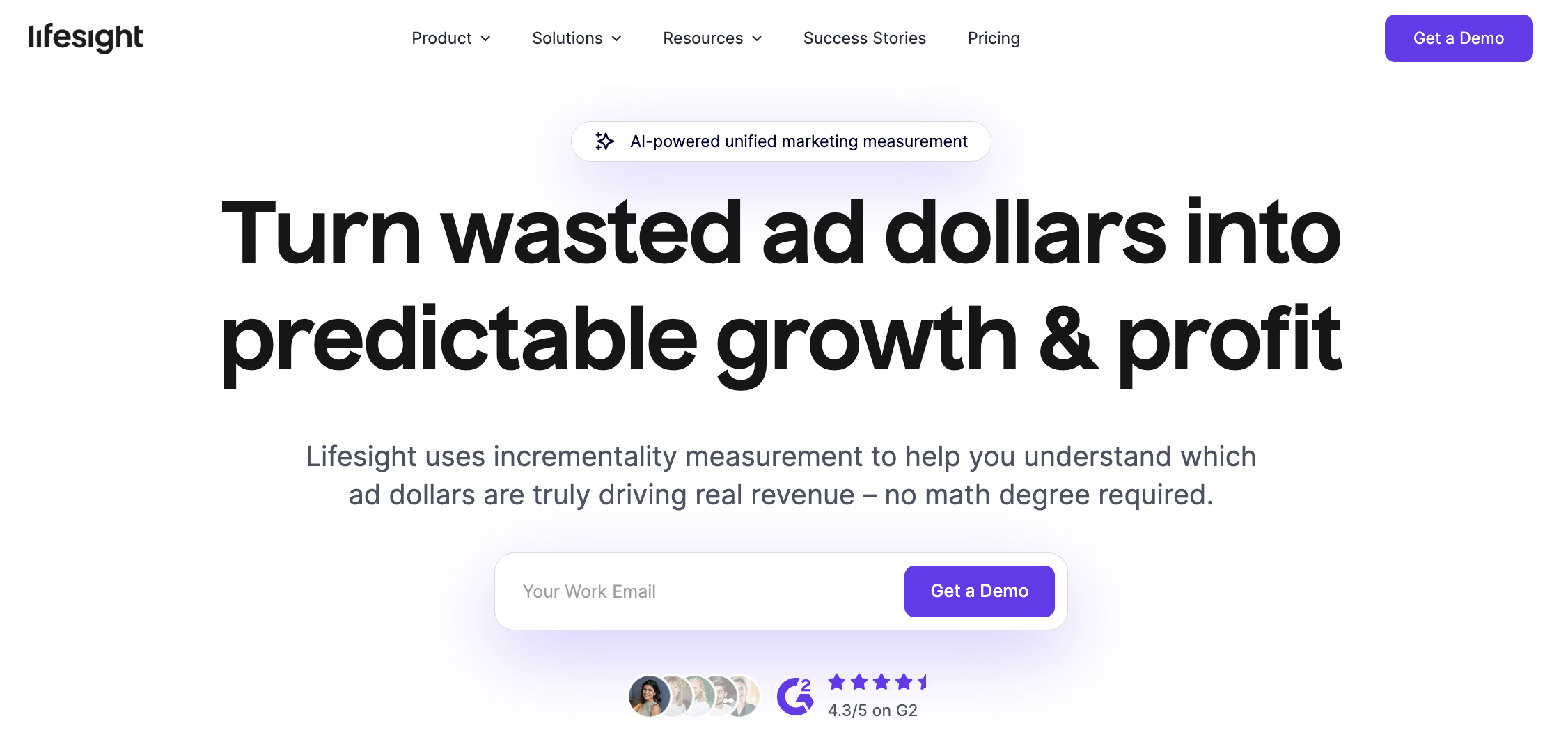
Lifesight’s UMM Best For
Lifesight’s UMM is best suited for mid-to-large Direct-to-Consumer (DTC), eCommerce, retail, and B2B SaaS brands. These industries benefit from Lifesight’s robust framework for analyzing complex marketing channels and driving insights for growth.
Lifesight’s UMM Using Models and Methodologies
Lifesight’s UMM leverages a unified marketing measurement framework that combines siloed methodologies such as Causal Marketing Mix Modeling, Geo-based Incrementality Testing, and Causal Attribution, all under one cohesive platform. By integrating these methods, Lifesight provides a holistic view of your marketing performance, allowing businesses to make data-driven decisions.
Lifesight’s UMM Key Features
- Integrated Framework: Combines multiple measurement techniques in one platform for a comprehensive marketing analysis.
- Advanced Attribution Models: Provides insights into customer behaviors and the impact of specific marketing actions.
- Real-Time Insights: Offers actionable data that allows businesses to adjust strategies in real time.
- Cross-Channel Performance Measurement: Tracks marketing performance across both online and offline channels, ensuring full-funnel analysis.
- Seamless Integrations: Easily integrates with other marketing and analytics platforms, allowing businesses to consolidate all their data into one unified view for more efficient decision-making.
Lifesight’s UMM Advantages
- Unified Reporting: Brings all marketing data into one cohesive report, providing a comprehensive view of performance across multiple channels. This simplifies analysis and decision-making.
- Full-Funnel Measurement: Tracks every stage of the customer journey, from awareness to conversion, helping businesses understand the impact of their marketing across the entire funnel.
- Eliminate Wasted Ad Spend: By identifying underperforming channels and strategies, Lifesight allows businesses to eliminate inefficient ad spend, ensuring every dollar is maximized for ROI.
- Identify High-Performing Channels and Marketing Efforts: Lifesight highlights the marketing channels and strategies delivering the best results, enabling businesses to focus their efforts on what works.
- Identify New Channel Opportunities: Using data-driven insights, Lifesight uncovers emerging marketing channels that can help businesses expand their reach and diversify their marketing strategies.
- Budget Allocation: With actionable insights, businesses can optimize their marketing budgets by directing funds to the highest-performing channels and strategies, ensuring maximum return on investment.
- Campaign Optimization: Lifesight helps businesses fine-tune their marketing campaigns based on real-time data, ensuring continuous improvement in performance.
- Optimize the Spend Level: Businesses can adjust their marketing spend dynamically, scaling up high-performing areas while scaling back on low-performing ones to maintain efficient expenditure.
- Scenario Planning and Forecasting: Lifesight allows businesses to plan and forecast different marketing scenarios based on historical data, helping them make informed decisions for future campaigns.
- Adapt to Seasonality and Promotions: Lifesight helps businesses quickly adapt their marketing strategies to seasonal trends and promotional events, ensuring campaigns are optimized for peak periods.
Lifesight’s UMM Disadvantages
- Due to its advanced features and comprehensive tools, Lifesight may be on the pricier side for smaller companies or startups.
- The integration of multiple methodologies can be overwhelming for smaller businesses or those with limited marketing expertise.
Lifesight’s UMM Pricings
Lifesight offers two pricing options: one for SMBs with a starter plan priced at $5K per month, and another for an enterprise plan, which is custom.
Know More About: Lifesight Pricing
Lifesight’s UMM Reviews
As per G2, Lifesight UMM has a rating of 4.1 out of 5.
Visit Lifesight –> Take a Product Tour –> Get Free Demo
2. Measured
Measured is one of the Unified Marketing Measurement (UMM) tools that combines Marketing Mix Modeling (MMM) and Multi-Touch Attribution (MTA) hybrid methodologies. It is designed to help businesses optimize their marketing performance by analyzing both macro and micro-level data across various channels.
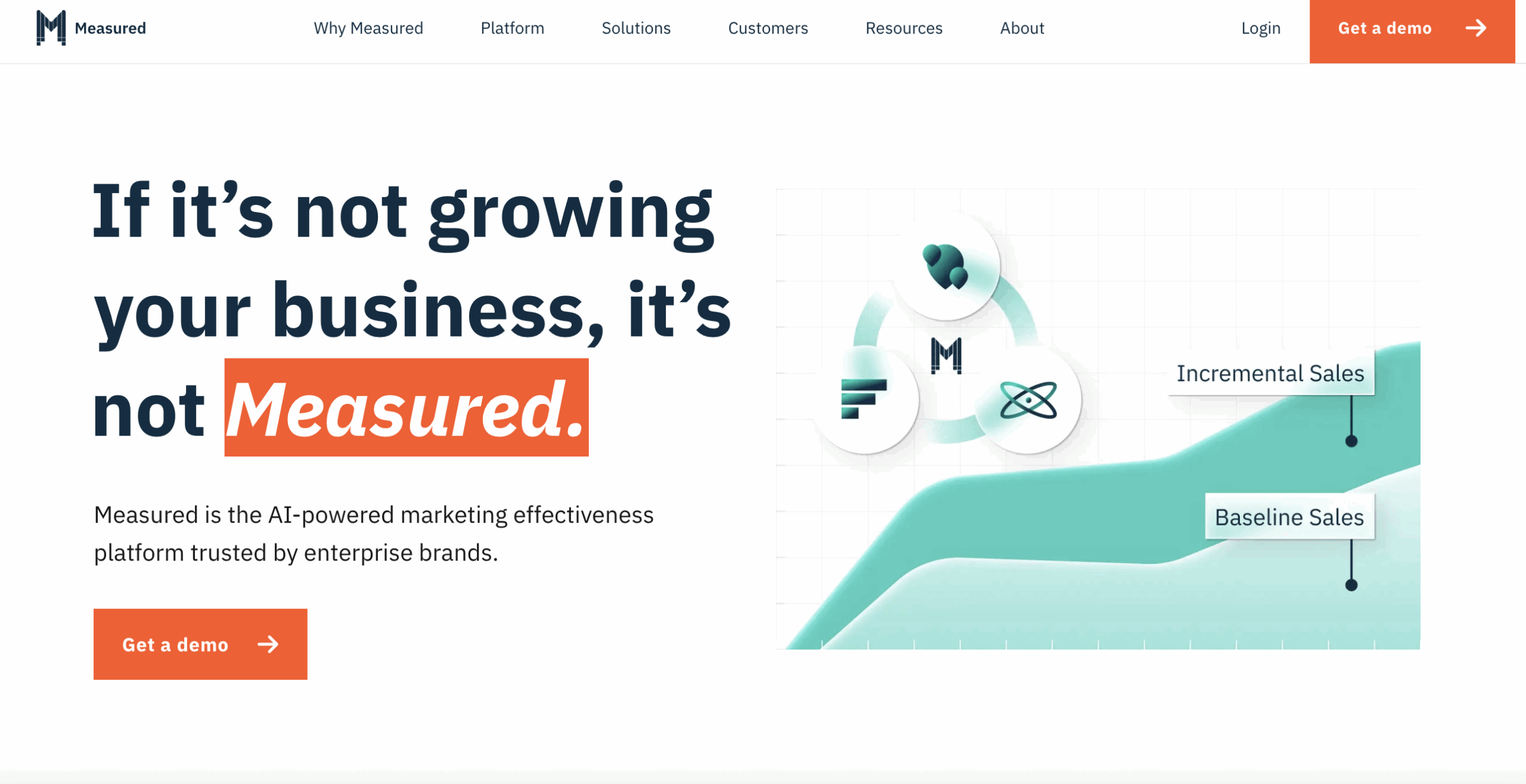
Measured’s UMM Best For
Measured UMM is ideal for omnichannel advertisers, offering a comprehensive view of marketing performance across all channels, including paid search, social, display, TV, and more. It helps these businesses improve their marketing strategies for greater efficiency and ROI.
Measured’s UMM Using Models and Methodologies
Measured utilizes a hybrid framework combining MMM and MTA to deliver a holistic view of marketing performance. By using both top-down and bottom-up methods, Measured provides an in-depth analysis of campaign effectiveness and customer journey mapping.
Measured’s UMM Key Features
- Hybrid Attribution Models: Combines MMM and MTA to offer both strategic and tactical insights.
- Real-Time Data Integration: Provides real-time data feeds to allow for immediate adjustments and optimization.
- Cross-Channel Measurement: Analyzes performance across all digital and traditional marketing channels.
- Customizable Dashboards: Allows businesses to create tailored reports to match their unique needs.
Measured’s UMM Advantages
- Omnichannel Insights: Provides visibility into all advertising channels, ensuring marketers can optimize their total media mix.
- Real-Time Adjustments: With real-time insights, businesses can make immediate changes to campaigns.
- Data-Driven Decision-Making: The hybrid approach allows for more nuanced, data-backed decisions, blending strategic and tactical insights.
Measured’s UMM Disadvantages
- Complex Setup: The combination of multiple methodologies may require additional time and resources for implementation.
- Pricing: As with many advanced UMM tools, pricing may be a concern for smaller businesses or those with limited budgets.
Measured’s UMM Pricing
Measured offers custom pricing, based on the specific needs of the business. Interested companies need to reach out for a personalized quote.
Measured’s UMM Reviews
As per G2, Measured UMM holds an impressive rating of 4.9 out of 5.
3. Rockerbox
Rockerbox is a comprehensive UMM tool that combines Marketing Mix Modeling (MMM) with Multi-Touch Attribution (MTA). It is designed for mid-market digital brands looking to gain detailed insights into their marketing performance and optimize their advertising spend.
Rockerbox’s UMM Best For
Rockerbox is best suited for mid-market digital brands that need precise measurement of digital marketing efforts. It helps businesses optimize their media mix and track conversions across different channels.
Rockerbox’s UMM Using Models and Methodologies
Rockerbox uses a combination of MMM and MTA, providing both high-level marketing effectiveness insights and granular attribution across all digital touchpoints. This dual methodology ensures accurate analysis of both long-term and short-term campaign performance.
Rockerbox’s UMM Key Features
- MMM + MTA Hybrid: Provides both top-down (MMM) and bottom-up (MTA) insights.
- Cross-Channel Attribution: Measures performance across all digital channels including search, display, social media, and more.
- Campaign Optimization: Helps businesses optimize their marketing campaigns based on detailed performance data.
- Real-Time Analytics: Offers up-to-date performance metrics for immediate adjustments.
Rockerbox’s UMM Advantages
- Comprehensive Attribution: Combines the strengths of MMM and MTA to deliver a thorough view of marketing performance.
- Actionable Insights: Provides insights that businesses can act on immediately to optimize campaign performance.
- Mid-Market Focus: Tailored for mid-market brands, offering powerful features without the complexity of enterprise tools.
Rockerbox’s UMM Disadvantages
- Pricing: Custom pricing may make it expensive for smaller businesses with tighter budgets.
- Complexity: The hybrid approach may require expertise to fully utilize all features effectively.
Rockerbox’s UMM Pricing
Rockerbox offers custom pricing based on the size and needs of the business.
Rockerbox’s UMM Reviews
As per G2, Rockerbox UMM has an excellent rating of 4.6 out of 5.
4. Haus
Haus is a specialized UMM tool focused on attribution and experimentation. It provides retailers with a unique approach to marketing measurement, enabling them to test different strategies and measure the direct impact on sales and customer behavior.

Haus’s UMM Best For
Haus is best suited for retail brands looking to optimize marketing performance through experimentation and attribution modeling. It’s ideal for businesses that want to understand the impact of different marketing strategies on consumer behavior and sales.
Haus’s UMM Using Models and Methodologies
Haus combines attribution modeling with experimentation, offering retailers the ability to test and measure the effectiveness of various marketing tactics. This allows for data-driven decision-making and campaign optimization based on real-world results.
Haus’s UMM Key Features
- Attribution and Experimentation: Combines attribution modeling with A/B testing for comprehensive insights.
- Real-Time Data: Provides immediate feedback on experiment results, allowing for quick adjustments.
- Retail Focus: Tailored specifically for retail brands, helping them understand the impact of their marketing efforts on consumer behavior.
Haus’s UMM Advantages
- Experimentation Driven: Provides a data-driven approach to testing marketing tactics and strategies.
- Retail-Focused: Offers unique tools specifically designed for retail brands.
- Optimized Campaigns: Helps retailers continuously refine and optimize their marketing campaigns based on data.
Haus’s UMM Disadvantages
- Limited to Retail: May not be as effective for businesses outside the retail sector.
- No Reviews: As a newer tool, there may be limited feedback available from users.
Haus’s UMM Pricing
Haus offers custom pricing tailored to the needs of the business.
Haus’s UMM Reviews
No available reviews yet.
5. LiftLab
LiftLab is an advanced UMM tool that combines Marketing Mix Modeling (MMM) with experimentation. It is designed for early-stage, fast-growing teams, providing them with the insights needed to optimize marketing campaigns and achieve scalable growth.
LiftLab’s UMM Best For
LiftLab is ideal for early-stage growth teams, especially in fast-moving industries, that need to understand the effectiveness of their marketing strategies and refine them for better results.
LiftLab’s UMM Using Models and Methodologies
LiftLab combines MMM with experimentation to offer deep insights into how different marketing activities impact customer behavior and overall growth. The tool helps businesses understand the broader marketing picture while testing specific strategies.
LiftLab’s UMM Key Features
- MMM + Experimentation: Combines strategic marketing mix insights with hands-on testing and optimization.
- Real-Time Adjustments: Provides real-time feedback for immediate optimization.
- Growth-Focused: Designed for fast-growing teams looking to scale their marketing efforts.
LiftLab’s UMM Advantages
- Growth-Focused: Perfect for early-stage teams that need to optimize marketing for scalable growth.
- Actionable Insights: Provides clear insights for improving marketing performance.
- Flexibility: Allows businesses to experiment with various marketing strategies and see what works best.
LiftLab’s UMM Disadvantages
- Limited to Early-Stage Teams: May not be suitable for large-scale enterprises with complex marketing needs.
- No Reviews: Limited user feedback available at this stage.
LiftLab’s UMM Pricing
LiftLab offers custom pricing based on the business’s specific needs.
LiftLab’s UMM Reviews
No available reviews yet.
6. Recast
Recast is an advanced UMM tool that uses causal MMM (Bayesian) modeling to offer analytics-heavy organizations deep insights into their marketing performance. It helps organizations optimize their marketing mix for better results.
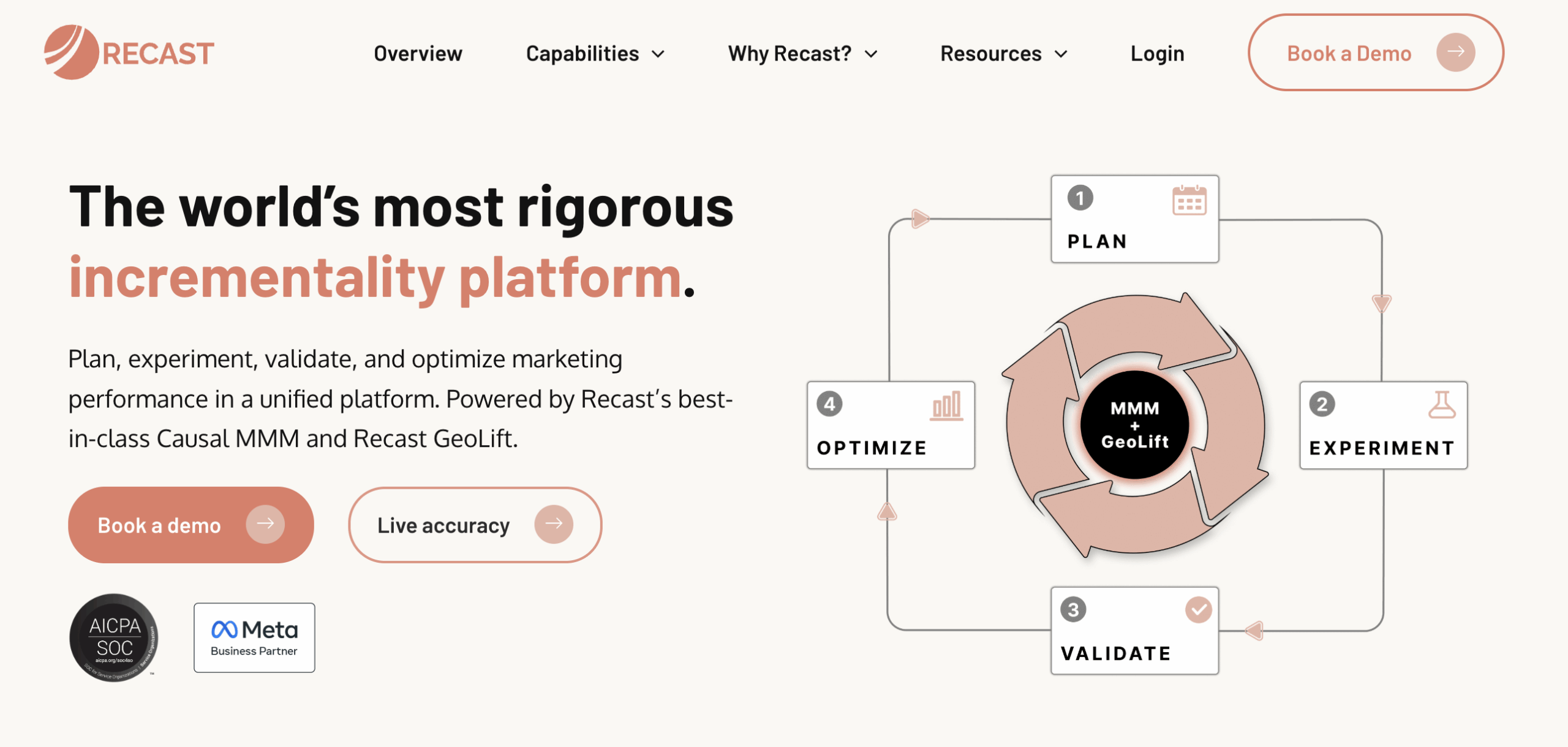
Recast’s UMM Best For
Recast is best suited for analytics-heavy organizations that rely heavily on data and want a deep, quantitative understanding of their marketing effectiveness.
Recast’s UMM Using Models and Methodologies
Recast uses causal MMM (Bayesian) to provide advanced statistical insights into marketing effectiveness. The Bayesian approach allows for highly accurate forecasting and decision-making based on historical data.
Recast’s UMM Key Features
- Bayesian Causal MMM: Uses advanced statistical models to measure the impact of marketing activities.
- Deep Analytics: Provides in-depth insights for organizations that need precise data analysis.
- Forecasting: Helps businesses forecast the impact of future marketing decisions.
Recast’s UMM Advantages
- Advanced Analytics: Provides high-level analytics for organizations looking for deep insights into their marketing performance.
- Causal Modeling: Allows businesses to understand the true causal relationships between marketing efforts and results.
Recast’s UMM Disadvantages
- Analytics-Heavy: May be too complex for businesses without strong data expertise.
- No Reviews: As with other tools, limited user reviews are available.
Recast’s UMM Pricing
Recast offers custom pricing based on the specific needs of the business.
Recast’s UMM Reviews
No available reviews yet.
Why Should Businesses Move Beyond Traditional Analytics and Choose Unified Marketing Measurement Approach?
Traditional analytics tools like Google Analytics 4, Google Ads, Meta (Facebook), HubSpot, Salesforce, and others primarily rely on last-touch attribution models. These tools attribute the entire conversion to the last interaction a customer had before converting, disregarding the influence of previous touchpoints. As a result, this single-touch bias leads to inaccurate conclusions and poor marketing decisions.
Even Multi-Touch Attribution (MTA), which attempts to consider multiple touchpoints, still has its limitations. MTA is often biased by privacy regulations like GDPR or Apple’s App Tracking Transparency, which limit the amount of customer data that can be collected across channels. With restricted access to customer-level data, MTA may miss essential interactions along the customer journey, leading to incomplete or skewed insights.
For Example,
Let’s say you’re running an awareness campaign for a new product launch on your e-commerce brand. You decide to use TV ads, OOH (Out-of-Home) ads, Radio ads, YouTube ads, and Google search ads. In this scenario, Person A saw your OOH ad, then listened to your Radio ad, and finally converted after watching your YouTube ad. According to traditional analytics, YouTube would receive full credit for the conversion, even though the OOH and Radio ads played a significant role earlier in the customer journey.
This last-touch attribution bias may lead you to wrongly assume that Radio and OOH ads aren’t performing well, and you might decide to cut these channels from your budget. However, when you eliminate these channels, you may notice a decline in conversions on YouTube, which were originally influenced by the other touchpoints.
This is where Incrementality Testing and Causal Attribution within a Unified Marketing Measurement (UMM) framework come in to provide more accurate and unbiased insights. Incrementality Testing allows you to measure the cause and effect of each marketing touchpoint by comparing the outcomes of a treatment group (those exposed to ads) against a control group (those who were not exposed). This helps identify the true incremental value of each channel.
Causal Attribution goes a step further by linking each touchpoint to its causal impact on the conversion, offering a clear understanding of what works and why. By using these methodologies together, businesses can make data-driven decisions that account for both direct and indirect effects of various channels, giving them a more complete view of their marketing performance.
With UMM, businesses can understand the full customer journey and make informed decisions about where to allocate resources, which channels to optimize, and which strategies to scale. This ensures that marketing efforts are based on unbiased, holistic data rather than flawed, single-touch models.
How to Choose the Best Unified Marketing Measurement Tools for My Business?
1. Assess Your Business Size and Needs
Choose a tool based on your business size. Larger brands may need advanced tools like Lifesight or Measured, while smaller businesses may prefer simpler options like LiftLab.
2. Understand the UMM Methodologies
Ensure the tool aligns with your needs:
- MMM for broad performance insights
- Incrementality Testing for cause-and-effect analysis
- Causal Attribution for understanding channel impact
- MTA for granular, multi-touch insights
3. Evaluate Cross-Channel Measurement
Opt for tools like Lifesight or Measured that provide cross-channel measurement across both online and offline platforms.
4. Look for Real-Time Data and Reporting
Choose tools offering real-time insights to quickly adjust campaigns (e.g., Lifesight or Measured).
5. Consider Pricing and Customization
Check pricing options; some tools are more affordable for smaller businesses, while others offer customizable enterprise plans.
6. Read Reviews and Case Studies
Look for user reviews and case studies to gauge effectiveness. Tools like Lifesight (4.1/ 5), Measured (4.9/5) and Rockerbox (4.6/5) show high customer satisfaction.
7. Evaluate Integration and Support
Ensure the tool integrates with your existing marketing platforms and offers strong customer support.
8. Test with a Trial
Use free trials or demos to test the tool’s functionality with your data before making a commitment.
Conclusion
Choosing the best Unified Marketing Measurement (UMM) tool for your business requires careful consideration of your goals, the tools’ capabilities, and your budget. By understanding the different methodologies, evaluating the tool’s features, and ensuring it integrates with your existing systems, you can make an informed decision that will help optimize your marketing performance. Whether you are a mid-market digital brand, a retail company, or an early-stage growth team, the right UMM tool will provide you with the insights needed to drive measurable growth.
You may also like
Essential resources for your success
